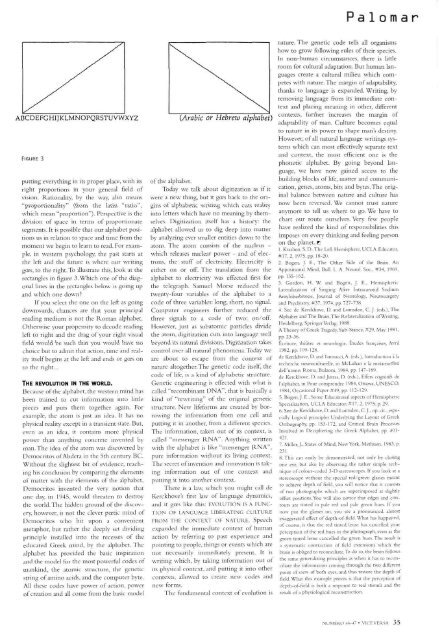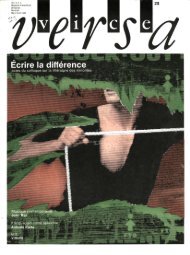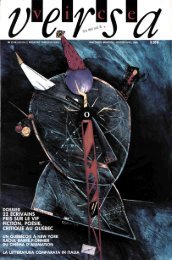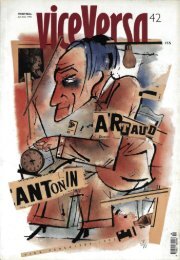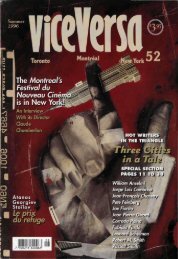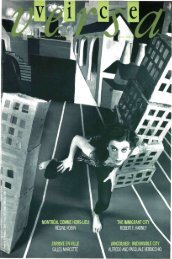N. 46/47 Palomar : voyeur, voyant, visionnaire - ViceVersaMag
N. 46/47 Palomar : voyeur, voyant, visionnaire - ViceVersaMag
N. 46/47 Palomar : voyeur, voyant, visionnaire - ViceVersaMag
Create successful ePaper yourself
Turn your PDF publications into a flip-book with our unique Google optimized e-Paper software.
ABCDEFGHIJKLMNOPQRSTUVWXYZ<br />
FIGURE 3<br />
putting everything in its proper place, with its<br />
right proportions in your general field of<br />
vision. Rationality, by the way, also means<br />
"proportionality" (from the latin "ratio",<br />
which mean "proportion"). Perspective is the<br />
division of space in terms of proportionate<br />
segments. It is possible that our alphabet positions<br />
us in relation to space and time from the<br />
moment we begin to learn to read. For example,<br />
in western psychology, the past starts at<br />
the left and the future is where our writing<br />
gees, to the right. To illustrate this, look at the<br />
rectangles in figure 3. Which one of the diagonal<br />
lines in the rectangles below is going up<br />
and which one down?<br />
If you select the one on the left as going<br />
downwards, chances are that your principal<br />
reading medium is not the Roman alphabet.<br />
Otherwise your propensity to decode reading<br />
left to right and the drag of your right visual<br />
field would be such that you would have no<br />
choice but to admit that action, time and reality<br />
itself begins at the left and ends or gees on<br />
to the right...<br />
THE REVOLUTION IN THE WORLD.<br />
Because of the alphabet, the western mind has<br />
been trained to cut information into little<br />
pieces and puts them together again. For<br />
example, the atom is just an idea. It has no<br />
physical reality except in a transient state. But,<br />
even as an idea, it contains more physical<br />
power than anything concrete invented by<br />
man. The idea of the atom was discovered by<br />
Democritos of Abdera in the 5th century BC.<br />
Without the slightest bit of evidence, reaching<br />
his conclusion by comparing the elements<br />
of matter with the elements of the alphabet,<br />
Democritos invented the very notion that<br />
one day, in 1945, would threaten to destroy<br />
the world. The hidden ground of the discovery,<br />
however, is not the clever pcetic mind of<br />
Democritos who hit upon a convenient<br />
metaphor, but rather the deeply set dividing<br />
principle installed into the recesses of the<br />
educated Greek mind, by the alphabet. The<br />
alphabet has provided the basic inspiration<br />
and the model for the most powerful codes of<br />
mankind, the atomic structure, the genetic<br />
string of amino acids, and the computer byte.<br />
All these codes have power of action, power<br />
of creation and all come from the basic model<br />
(Arabic or Hebrew alphabet)<br />
of the alphabet.<br />
Today we talk about digitization as if it<br />
were a new thing, but it gees back to the origins<br />
of alphabetic writing which cuts reality<br />
into letters which have no meaning by themselves.<br />
Digitization itself has a history: the<br />
alphabet allowed us to dig deep into matter<br />
by analyzing ever smaller entities down to the<br />
atom. The atom consists of the nucleus -<br />
which releases nuclear power - and of electrons,<br />
the stuff of electricity. Electricity is<br />
either on or off. The translation from the<br />
alphabet to electricity was effected first for<br />
the telegraph. Samuel Morse reduced the<br />
twenty-four variables of the alphabet to a<br />
code of three variables: long, short, no signal.<br />
Computer engineers further reduced the<br />
three signals to a code of two: on/off.<br />
However, just as subatomic particles divide<br />
the atom, digitization cuts into language well<br />
beyond its natural divisions. Digitization takes<br />
control over all natural phenomena.Today we<br />
are about to escape from the context of<br />
nature altogether.The genetic code itself, the<br />
code of life, is a kind of alphabetic structure.<br />
Genetic engineering is effected with what is<br />
called "recombinant DNA", that is basically a<br />
kind of "rewriting" of the original genetic<br />
structure. New lifeforms are created by borrowing<br />
the information from one cell and<br />
putting it in another, from a different species.<br />
The information, taken out of its context, is<br />
called "messenger RNA". Anything written<br />
with the alphabet is like "messenger RNA",<br />
pure information without its living context.<br />
The secret of invention and innovation is taking<br />
information out of one context and<br />
putting it into another context.<br />
There is a law, which you might call de<br />
Kerckhove's first law of language dynamics,<br />
and it gees like this: EVOLUTION IS A FUNC<br />
TION OF LANGUAGE LIBERATING CULTURE<br />
FROM THE CONTEXT OF NATURE. Speech<br />
expanded the immediate context of human<br />
action by referring to past experience and<br />
pointing to people, things or events which are<br />
not necessarily immediately present. It is<br />
writing which, by taking information out of<br />
its physical context, and putting it into other<br />
contexts, allowed to create new codes and<br />
new forms.<br />
The fundamental context of evolution is<br />
Pa 1 o m ar<br />
nature. The genetic code tells all organisms<br />
how to grow following rules of their species.<br />
In non-human circumstances, there is little<br />
room for cultural adaptation. But human languages<br />
create a cultural milieu which competes<br />
with nature. The margin of adaptability,<br />
thanks to language is expanded. Writing, by<br />
removing language from its immediate context<br />
and placing meaning in other, different<br />
contexts, further increases the margin of<br />
adaptability of man. Culture becomes equal<br />
to nature in its power to shape man's destiny.<br />
However, of all natural language writings systems<br />
which can most effectively separate text<br />
and context, the most efficient one is the<br />
phonetic alphabet. By going beyond language,<br />
we have now gained access to the<br />
building blocks of life, matter and communication,<br />
genes, atoms, bits and bytes. The original<br />
balance between nature and culture has<br />
now been reversed. We cannot trust nature<br />
anymore to tell us where to go. We have to<br />
chart our route ourselves. Very few people<br />
have realized the kind of responsibilities this<br />
imposes on every thinking and feeling person<br />
on the planet. B<br />
1. Krashcn, S. D..The Left Hemisphere, UCLA Educator.<br />
#17,2. 1975. pp. 18-20.<br />
2. Bogen. J. E.. The Other Side of the Brain. An<br />
Apposirional Mind. Bull. L. A. Neurol. Soc. #34. 1969.<br />
pp. 135-162.<br />
3. Gordon, H. W. and Bogen, J. E., Hemispheric<br />
Lateralization of Singing After Intracarotid Sodium<br />
Amylobarbitonc, Journal of Neurology, Neurosurgery<br />
and Psychiatry. #37.1974, pp. 727-738.<br />
4. See de Kerckhove, D. and Lumsden, G J. (eds.). The<br />
Alphabet and The Brain.The Relateralization ofWriring,<br />
Heidelberg, Springer Verlag, 1988.<br />
A Theory of Greek Tragedy. Sub-Stance, #29. May 1981,<br />
pp. 23-36.<br />
Écriture, théâtre et neurologic Etudes françaises, Avril<br />
1982. pp. 109-128.<br />
de Kerckhove. D. and lannucci. A. (eds.), Introduction à la<br />
recherche neuroculturelle, in McLuhan e la mctamorfbsi<br />
dell'uomo. Roma. Bulzoni, 1984. pp. 1<strong>47</strong>-189.<br />
de Kerckhove. D. and Jutras, D. (eds.). Effets cognitifs de<br />
l'alphabet, in Pour comprendre 1984, Ottawa. UNESCO.<br />
1984, Occasional Paper #49, pp. 112-129.<br />
5. Bogen. J- E., Some Educational aspects of Hemispheric<br />
Specialization, UCLA Educator. #17,2,1975, p. 29.<br />
6. See de Kerckhove, D. and Lumsden, C. J., op. cit., especially<br />
Logical principles Underlying the Layout of Greek<br />
Ordiography, pp. 153-172, and Critical Brain Processes<br />
Involved in Deciphering the Greek Alphabet, pp. 401-<br />
421.<br />
7. Miller. J.. States of Mind. New York, Methuen, 1983. p.<br />
231.<br />
8. This can easily be demonstrated, not only by closing<br />
one eye, but also by observing the rather simple technique<br />
of colour-coded 3-D stereoscopes. If you look at a<br />
stereoscope without the special red/green glasses meant<br />
to achieve depth of field, you will notice that it consists<br />
of two photographs which are superimposed at slighdy<br />
ofiset positions. You will also notice that edges and contours<br />
are tinted in pale red and pale green hues. If you<br />
now put the glasses on, you see a pronounced, almost<br />
exaggerated effect of depth-of-field. What has happened.<br />
of course, is that the red tinted lense has cancelled your<br />
perception of the red hues in the photograph, even as the<br />
green tinted lense cancelled the green hues. The result is<br />
a systematic contraction of field extensions which the<br />
brain is obliged to reconciliate.To do so. the brain follows<br />
the same generalizing principles as when it has to reconcihate<br />
the information coming through the two different<br />
point of view of both eyes, and thus restore the depth ot<br />
field. What this example proves is that the perception of<br />
depth-of-field is both a response to real stimuli and the<br />
result of a physiological reconstruction.<br />
NUMÉRO <strong>46</strong>-<strong>47</strong> • VICE VERSA 35


